-
Paper Information
- Previous Paper
- Paper Submission
-
Journal Information
- About This Journal
- Editorial Board
- Current Issue
- Archive
- Author Guidelines
- Contact Us
International Journal of Materials Engineering
p-ISSN: 2166-5389 e-ISSN: 2166-5400
2014; 4(3): 114-118
doi:10.5923/j.ijme.20140403.07
Evaluation of Quality in the Adhesion of Glued Laminated Timber (Glulam) of Paricá and Lyptus Wood Species
Diego Henrique de Almeida1, Raquel Schmitt Cavalheiro2, Laurenn Borges de Macêdo2, Carlito Calil Neto3, André Luis Christoforo4, Carlito Calil Junior5, Francisco Antonio Rocco Lahr5
1Pontifical Catholic University of Minas Gerais (PUC Minas), Department of Civil Engineering, Poços de Caldas Campus, Poços de Caldas, 37701-355, Brazil
2Department of Materials Engineering (SMM), Engineering School of São Carlos (EESC/USP), São Carlos, 13566-590, Brazil
3Wood and Timber Structures Laboratory (LaMEM), Engineering School of São Carlos (EESC), São Carlos, 13566-590, Brazil
4Centre for Innovation and Technology in Composites (CITeC), Department of Civil Engineering (DECiv), Federal University of São Carlos (UFSCar), São Carlos, 13565-905, Brazil
5Department of Structures Engineering (SET), Engineering School of São Carlos (EESC/USP), São Carlos, 13566-590, Brazil
Correspondence to: André Luis Christoforo, Centre for Innovation and Technology in Composites (CITeC), Department of Civil Engineering (DECiv), Federal University of São Carlos (UFSCar), São Carlos, 13565-905, Brazil.
| Email: |  |
Copyright © 2014 Scientific & Academic Publishing. All Rights Reserved.
This research aims to study the shear strength of species-adhesive-moisture-waterproofing combinations and delamination of Glued Laminated Timber (Glulam) made with Paricá (Schizolobium amazonicum Herb) and Lyptus Wood species, using two different adhesives, the bicomponent resorcinol-formaldehyde based adhesive (CASCOPHEN RS-216-M) with catalyst FM-60-M and the bicomponent melamine-urea based adhesive with catalyst AkzoNobel MUF 1242/2542, both in a proportion of 100 parts/adhesive mass and 20 parts/catalyst mass and waterproofed by the commercial product ProtectGuard. Shear strength tests in adhesion line were performed according to North American Standard AITC 190: 2007 and delamination tests were carried out obeying Canadian Code CSA 0177: 2006. The results show that average values of great shear strength were obtained in tests on the glue line of the specimens treated with the waterproofer, however, within them, the timber was dry. Lyptus Glulam beams did not present a performance in delamination that was compatible to external applications, but Paricá beams are fit to this use, once they are previously treated.
Keywords: Glulam, Quality in the adhesion, Shear strength, Delamination
Cite this paper: Diego Henrique de Almeida, Raquel Schmitt Cavalheiro, Laurenn Borges de Macêdo, Carlito Calil Neto, André Luis Christoforo, Carlito Calil Junior, Francisco Antonio Rocco Lahr, Evaluation of Quality in the Adhesion of Glued Laminated Timber (Glulam) of Paricá and Lyptus Wood Species, International Journal of Materials Engineering , Vol. 4 No. 3, 2014, pp. 114-118. doi: 10.5923/j.ijme.20140403.07.
Article Outline
1. Introduction
- Wood is one of the oldest materials used by humans in several applications. One of the most important has been the assembling of structures for housing, and also to overcome natural obstacles. However, with the discovery of steel and concrete, wood lost its main role in construction.Nowadays, there is a search for renewable resources, looking for lower environmental damage in the use of natural resources in human activities, and the timber from reforestation is a promising raw material, concerning sustainability, for all the engineered timber products.Many considerations can employed concerning the growing of timber products in construction, including: forestry management, sawmill and industrial benefiting, fast light-weight timber structures industrialization, reforestation of exotic and native species, use of higher quality preservatives, among others [1, 2]Of the several kinds of engineered timber products, one can cite, the Glued Laminated Timber (Glulam) (Figure 1), which represents a material built by gluing wood boards to one another in such a way that the grains remain parallel [3].
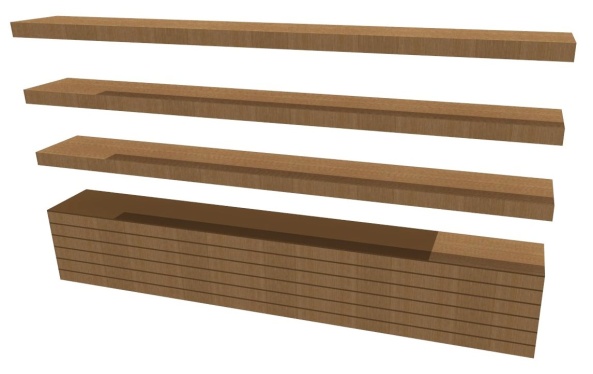 | Figure 1. Scheme of the assemblage of a structural beam of Glulam |
2. Material and Methods
- The experimental tests was developed in the Wood and Timber Structures Laboratory (LaMEM), of the Department of Structural Engineering (SET), of the School of Engineering of São Carlos (EESC), of the University of São Paulo (USP) according to the specifications defined by ABNT NBR 7190:1997 [13], AITC 190:2007 [14] and CSA 0177:2006 [15] Codes.For the tests, four beams of Glulam were made, with three blades each, after these were visually classified, followed by transversal vibration. Two of the beams were prepared with Paricá and two with Lyptus. For both wood species, one beam was prepared with a resorcinol-formaldehyde (CASCOPHEN RS-216-M) as adhesive, and FM-60-M catalyst and the other beam was glued with a melamine-urea adhesive and Akzo Nobel MUF 1242/2542 catalyst; the same procedure is used in beams of Lyptus. The Cascophen adhesive were made with catalyst FM-60-M and the bicomponent melamine-urea based adhesive with catalyst AkzoNobel MUF 1242/2542, both in a proportion of 100 parts/adhesive mass and 20 parts/catalyst mass and waterproofed by the commercial product ProtectGuard.For each beam, 9 test specimens were made for the shear test in the glue line, according to the AITC 190:2007 [14] standard. Three of these specimens were treated with the waterproofing agent ProtectGuard (Figure 2), and immersed in water for 48 h (Figure 3). The other specimens were not treated with the waterproofing agent and also immersed in water for 48 h (Figure 4), and other three were kept at room humidity (Figure 5).
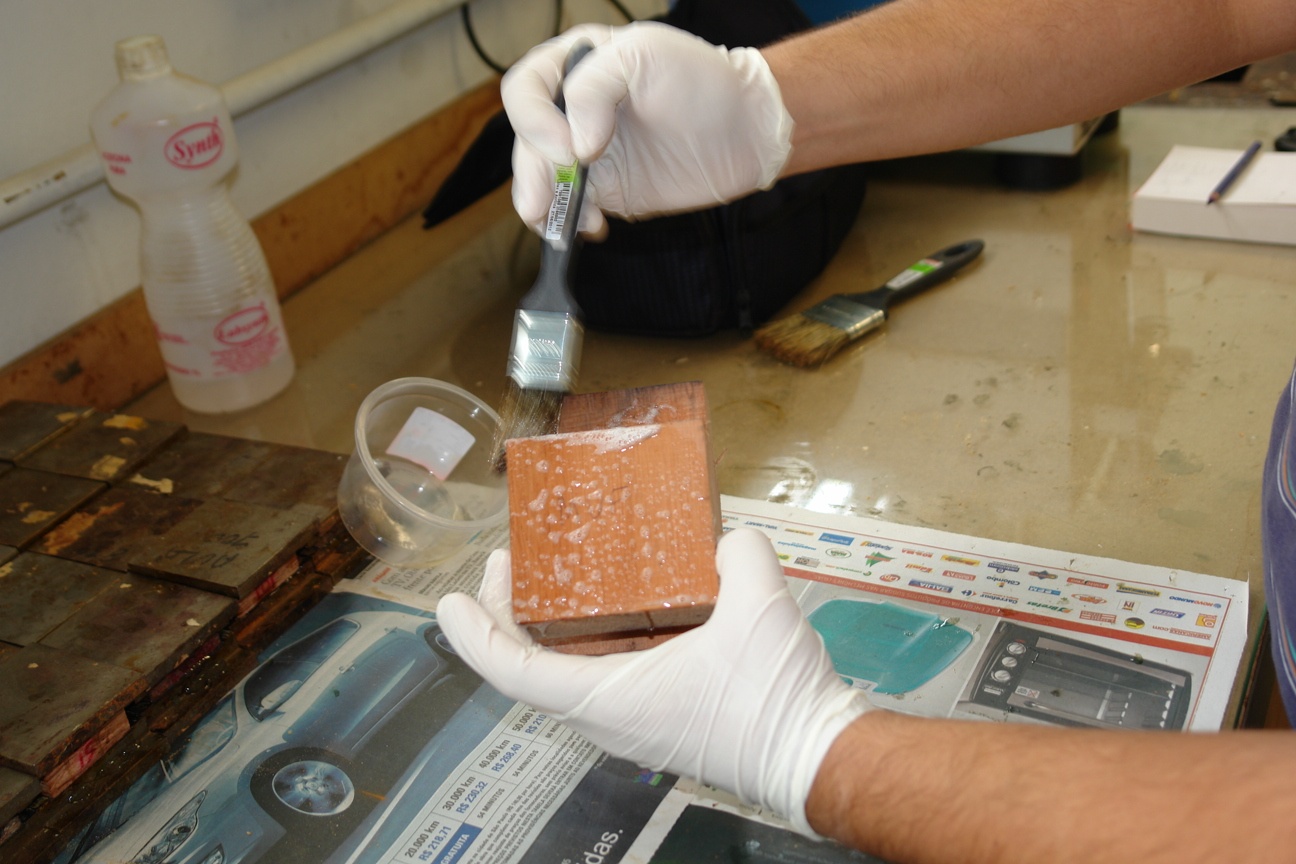 | Figure 2. Specimen being coated with the ProtectGuard waterproofing agent |
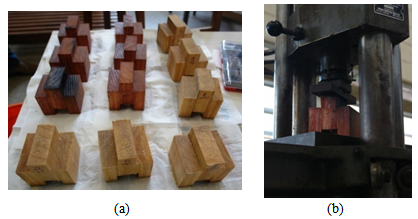 | Figure 3. (a) Specimens coated with the waterproofing ProtectGuard agent after immersion in water for 48 hours; (b) specimen of Lyptus with MUF waterproofed adhesive in test |
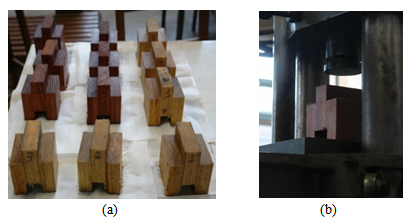 | Figure 4. (a) Specimens without waterproof coating after immersion in water for 48 hours; (b) specimen of Lyptus with CASCOPHEN adhesive in test |
 | Figure 5. (a) Specimens without waterproofing coating, kept at ambient humidity; (b) specimen of Paricá with dry MUF adhesive in test |
 | (1) |
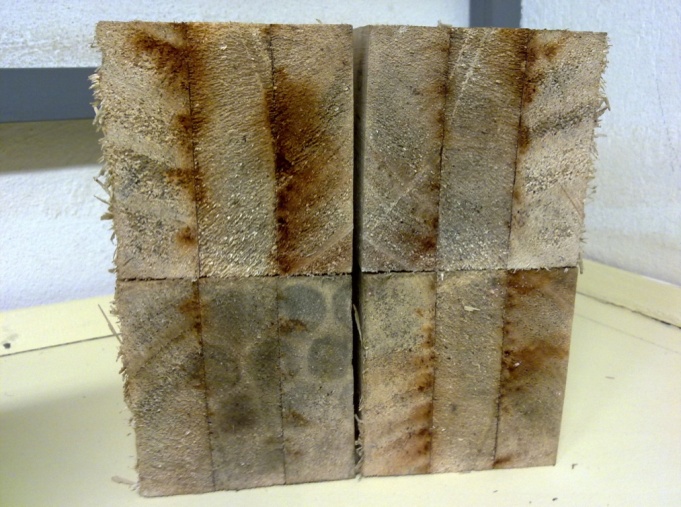 | Figure 6. Structural Paricá specimen for delamination tests |
3. Results and Discussions
- Table 1 shows average values and the variation coefficient of shear resistance in the glue line of dry, humid and waterproofed with three test specimens each.
 | Figure 7. Waterproofed Lyptus specimen at the end of the shear test, showing that the wood inside is still dry, even after 48 h immersion in water |
|
4. Conclusions
- The waterproofing agent used in this research did not interfere with the strength in the glue line, during the shear tests. However, when it is used, the wood is still dry inside the sample, what reduces the risks of attacks of wood decay organisms that degrade the wood, during its application.Beams produced with Lyptus wood and resorcinol-formaldehyde and melamine-urea adhesives were qualified for indoor use, because of their high percentage of delamination (exceeding 1%).Paricá is a great species of wood for the production of Glulam, however it should always be treated with a preservative agent, and should be used for outdoor environment.
ACKNOWLEDGMENTS
- The authors would like to acknowledge the responsible for the Wood and Timber Structures Laboratory (LaMEM), of the Department of Structural Engineering (SET), of the School of Engineering of São Carlos (EESC), of the University of São Paulo (USP), for the availability of resources and materials during the realization of this work. Thanks also to the Brazilian agencies CAPES and CNPq for their partnerships and research grants.
References
| [1] | Bertolini, M. S. Emprego de resíduos de Pinus sp tratado com preservante CCB na produção de chapas de partículas homogêneas utilizando resina poliuretana à base de mamona. Dissertação de Mestrado. Interunidades em Ciência e Engenharia de Materiais, Universidade de São Paulo, São Carlos, 2011. |
| [2] | Morales, E. A. M. Determinação do módulo de elasticidade da madeira: proposta para a simplificação de procedimentos metodológicos. Dissertação de Mestrado. Interunidades em Ciência e Engenharia de Materiais, Universidade de São Paulo, São Carlos, 2005. |
| [3] | Miotto, J. L. Estruturas mistas de madeira-concreto: avaliação das vigas de madeira laminada colada reforçadas com fibras de vidro. Tese de Doutorado. Departamento de Engenharia de Estruturas, Escola de Engenharia de São Carlos, Universidade de São Paulo, São Carlos, 2009. |
| [4] | Aprilanti, M. D. Influência de um corte na borda tracionada de uma viga maciça simulando uma emenda de topo na lâmina inferior de vigas laminadas coladas. Dissertação de Mestrado. Escola Superior de Agricultura “Luiz de Queiróz”, Universidade de São Paulo, Piracicaba, 2010. |
| [5] | Pizzi, A. Advanced wood adhesives technology. Marcel Dekker, New York, 1994. |
| [6] | Calil Neto, C. Madeira laminada colada (MLC): controle de qualidade em combinações espécie-adesivo-tratamento preservativo. Dissertação de Mestrado. Interunidades em Ciência e Engenharia de Materiais, Universidade de São Paulo, São Carlos, 2011. |
| [7] | Calil Junior, C.; Lahr, F. A. R; Dias, A. A. Dimensionamento de elementos estruturais de madeira. Manole, Barueri, 2003. |
| [8] | Ferro, F. S. Painéis OSB com madeira Schizolobium amazonicum e resina poliuretana à base de óleo de mamona. Dissertação de Mestrado. Escola de Engenharia de São Carlos, Universidade de São Paulo, São Carlos, 2013. |
| [9] | Almeida, D. H.; Cavalheiro, R. S.; Scaliante, R. M.; Christoforo, A. L.; Calil Junior, C.; Lahr, F. A. R. Full characterization of strength properties of Schizolobium amazonicum Wood for timber structures, International Journal of Engineering & Technology, v. 13, n.6, p. 97-100, 2013. |
| [10] | Almeida, D. H.; Scaliante, R. M.; Macêdo, L. B.; Macedo, A. N.; Dias, A. A.; Christoforo, A. L.; Calil Junior, C. Caracterização complete da Madeira da espécie amazônica Paricá (Schizolobium amazonicum HERB) em peças de dimensões estruturais, Revista Árvore, v. 37, n.6, p. 1175-1181, 2013. |
| [11] | Icimoto, F. H.; Ferro, F. S.; Varanda, L. D.; Souza, A. M.; Almeida, D. H.; Christoforo, A. L.; LAHR, F. A. R.. Physical and mechanical properties of Paricá wood species treated with CCB preservative, International Journal of Materials Engineering, v. 3, p. 82-86, 2013. |
| [12] | Associação Brasileira de Normas Técnicas. NBR 7190: Projeto de estruturas de madeira. Rio de Janeiro, 1997. |
| [13] | AITC 190:2007. Structural glued laminated timber. Colorado, 2007. |
| [14] | CSA 0177:2006. Qualification code for manufacturers of structural glued-laminated timber. Edmonton, 2006. |
| [15] | Almeida, D. H.; Scaliante, R. M.; Macêdo, L. B.; Macedo, A. N.; Calil Junior, C. Madeira laminada colada (MLC) da espécie Paricá, Madeira: Arquitetura e engenharia, v. 12, p. 71-82, 2011. |
 Abstract
Abstract Reference
Reference Full-Text PDF
Full-Text PDF Full-text HTML
Full-text HTML